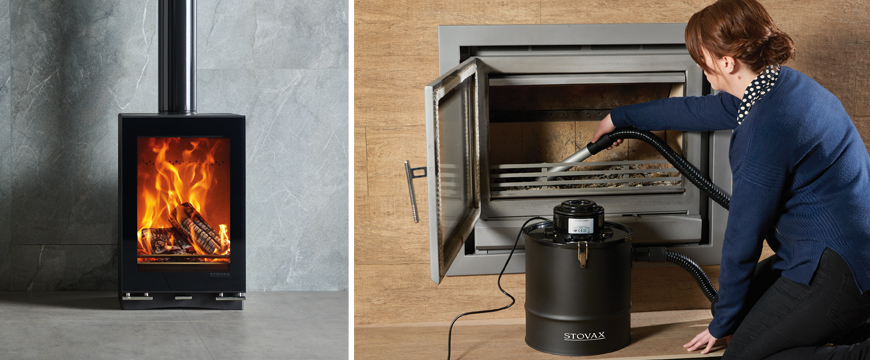
It is important to clean your wood burning or multi-fuel stove at the end of periods of use – a good time to do this is when spring months come about and you are using your stove or fire less. Here are our tips on how to service, clean and maintain your stove.
An annual service includes stripping and cleaning the appliance thoroughly, and one of the first things to do is to clean the inside of the firebox. To do this, wait until the stove is completely cool, and then remove all of the excess ash. Finer particles can be vacuumed up – we recommend using our Stovax Motorised Ashclean for this, as it is perfect for getting into awkward spots.
Next, the firebricks should be checked using a soft brush. Any that are broken or damage need to be replaced, but for smaller cracks, you can use Stovax Fire Cement to repair them.

Likewise, the door glass of your woodburner needs to be checked for any signs of damage. If the glass has cracked, it will need replacing, but if not, go ahead and clean thoroughly by removing it from the door and cleaning with an appropriate glass cleaner. It’s important to remember that different kinds of glass need different cleaning products – check which one is appropriate for your stove or fire by contacting us if you are unsure.
Check your stove’s door rope seal for signs of wear, as these can also become loose over time. If it needs replacing, watch our useful video which will guide you on how to change the seal.
If both your seal and door glass are in good condition, you can fit the glass back into the door – your woodburner is now thoroughly cleaned and serviced.
Just as your woodburner needs maintaining, so does your chimney. Anything from tar to birds’ nests can get stuck in your flue, so it’s essential to consider when you last had your chimney swept and whether or not you’ll need to do it again soon.
How often you have your chimney swept does depend on a variety of things:
• How often you use your fire or stove
• The fuel type you burn (e.g if burning smokeless fuels)
• The moisture content in the wood you burn
• What type of chimney you have
To find out more about how often you’ll need to sweep your chimney, and other chimney maintenance tips, read our blog.
Many of us make home improvements during the spring, so now could be the ideal time to replace your open fire or old stove with a new Ecodesign Ready product that is not only more efficient but also minimises emissions from wood burning.
The Ecodesign Ready scheme has been put into place to ensure new wood burning stoves and fires meet high environmental standards, minimising emissions for cleaner burning products.

Make sure that you burn good wood to get the most from your Ecodesign Ready stove or fire – it is widely known that burning bad quality, wet wood results in poor quality combustion, increased smoke and the production of tars and creosotes that will damage your flue. You can be sure that you are burning the right firewood if you check for the Woodsure ‘Ready to Burn‘ label which indicates that the firewood you have chosen is of good quality. You can read more about identifying good firewood here.
Sign up to our newsletter and receive the latest news and updates, including product launches, offers and promotions, exclusive giveaways and competitions, as well as seasonal tips and advice.
Subscribe Now!
Leave a Reply